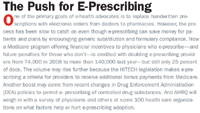E-Health to Drive Drug Safety
Pharmaceutical Executive
FDA's new Sentinel System is going live, but the signals may be difficult to assess.
Public and private healthcare experts have been struggling for years to establish electronic health information systems that can track and transfer a broad range of data in patient medical records. However, the inability of the nation's fragmented health IT (HIT) systems to communicate with one another has made the task extremely difficult, as do concerns about patient privacy and protecting access to personal health information.

Jill Wechsler
A main strategy of e-health advocates is to offer incentives to spur physician adoption of electronic health record systems (EHRs), as seen in provisions in a 2008 Medicare bill and the 2009 stimulus legislation. The Health IT (HITECH) portion of that legislation also encourages electronic prescribing by making that process one of several criteria providers must meet to make "meaningful use" of certified EHR systems, thus qualifying for $20 billion in Medicare bonus payments and avoiding future penalties [see sidebar].

The Push for E-Prescribing
The legislation also strengthens privacy and disclosure requirements to enhance public trust in EHR programs. In the process, though, it threatens to restrict the services that pharma marketers and other third parties can offer healthcare plans and providers, such as medication reminders and disease management.
Active Surveillance
Increased connectivity among healthcare entities promises to affect more efficient drug testing and development, along with more timely medical product monitoring and oversight. To take advantage of these developments, FDA is updating internal IT operations, partly in response to a 2007 report from the FDA Science Board describing the sorry state of the agency's IT infrastructure.
One goal is to provide information on the safety of regulated products more quickly. To this end, FDA is centralizing adverse event (AE) analysis through an all-FDA Adverse Event Reporting Systems (FAERS), and is creating a MedWatch Plus single portal for public AE reporting. Probably the most high profile project is to establish a proactive electronic information system able to monitor health records on 100 million people by July 2012, as required by the FDA Amendments Act of 2007 (FDAAA).
To meet this deadline, FDA launched the Sentinel Initiative in 2008, and now is establishing a "mini-Sentinel" system that will tap into medical records held by large health plans and insurers to monitor for certain events and assess evidence of health conditions associated with drug use. FDA recently signed a $72 million contract with the Harvard Pilgrim Health Care system to implement a distributed data model that will enable FDA to query databases established by CIGNA, Kaiser Permanente, and the HMO Research Network, among others. The initiative already has access to information on 60 million patients, according to project director Richard Platt of Harvard Pilgrim and Harvard Medical School. That's well above the initial FDAAA requirement of 25 million patients by July 1, 2010. A second phase next year will permit direct FDA access to de-identified health records from Medicare and other government health programs.
Platt and others discussed the technical, legal, and administrative issues involved in building the Sentinel System at a January workshop organized by Mark McClellan, former FDA commissioner and now director of the Engelberg Center for Health Care Reform at the Brookings Institution. FDA commissioner Margaret Hamburg opened the conference by emphasizing her support for better postmarketing surveillance of regulated products. To have a fully functioning Sentinel System, she urged consensus on methodologies for proving and disproving causal relationships between a product and an outcome.
Janet Woodcock, director of the Center for Drug Evaluation and Research (CDER), described Sentinel as one element in a broader FDA effort to encourage safe use of medications, revamp the agency's pharmacovigilance system, explore the use of social media to publicize safety issues, and better understand drug effects in different populations through worldwide collaborations. Sentinel is "very much a work in progress," Woodcock commented.
Privacy and Participation
FDA's decision to launch Sentinel based on a distributed data model reflects earlier research by academic experts and by the Observational Medical Outcomes Partnership (OMOP) suggesting that this approach can best ensure the privacy and security of patient health records. Instead of FDA building its own mega-database, this strategy leaves individual patient information with the healthcare system that holds the records; that organization then evaluates the information, transmits summaries to Sentinel and confirms a specific diagnosis or report if needed. But even with the ability to do their own analysis on the de-identified data from Medicare, FDA experts still may find it hard to confirm that a safety issue is real.
Another tricky topic for sponsors and policymakers is the timing of public disclosure of safety information. A "too early" release increases the possibility that a report may be wrong or incomplete and thus raises unnecessary alarm. But delaying communication on an emerging safety issue could result in patient harm, and expose program participants to "failure to warn" liability charges. Legal experts want FDA to develop model procedures for when, how, and to whom drug safety findings will be reported in order to set a policy that can be applied in court.
All of these issues will shape how FDA interprets and utilizes Sentinel findings in regulatory decision-making. Confirmation of safety signals could result in changes to a product's labeling, agency alerts to health care professionals, and public warnings about appropriate drug use. Mini-Sentinel will work with researchers and technical experts at academic centers, private firms, and nonprofit organizations to address these concerns by examining methods for querying against a common data model and seeking policies for validating and analyzing information from diverse information sources. Despite concerns about the completeness, objectivity, and timing of drug safety reports, Woodcock maintains that "what we're going to get is going to be better that what we have right now."
Pharma companies want to be at the table when such important issues are discussed and decided, but fear they will be excluded from the process. There are no industry representatives on the Sentinel planning board, and OMOP—an industry-funded collaboration involving FDA, the Foundation for the National Institutes of Health and the Pharmaceutical Research and Manufacturers of America (PhRMA)—is not an official participant in the program. At the Sentinel workshop, Patrick Ryan, manager of drug development sciences at GlaxoSmithKline, noted the strong support of OMOP members for Sentinel, and said that the group is providing public access to all of its research findings, such as assessment of the diversity in analysis methods and of relationships between drug exposure and outcomes.
Pharma companies hope to access Sentinel data for their own internal analyses and for postmarketing studies, but anticipate having to build their own versions of Sentinel if forced to generate their own safety data. Woodcock noted that the mini-Sentinel system can't yet support third party postmarketing analysis, and that FDA will have to deal with industry access once the full "industrial strength Sentinel" emerges.
The Broader system
While Sentinel's prime purpose is to serve FDA's regulatory mission, the long term vision is that it will be part of a larger health information system that also provides data for outcomes studies, comparative effectiveness research (CER), and health system quality reporting. Manufacturers support such a multi-purpose network, but recognize that it will require more investment in research methods, governance, and standards for data sources and evidence.
Carolyn Clancy, director of the Agency for Healthcare Research and Quality, concluded the workshop by describing AHRQ initiatives to improve patient registries and to build distributed data research networks that can answer queries related to the effectiveness and safety of medical services and products. These activities reflect the overarching goal of identifying synergies between post-market surveillance and CER, while also providing incentives for health care providers to participate in e-health activities.
Jill Wechsler is Pharmaceutical Executive's Washington correspondent. She can be reached at jwechsler@advanstar.com
FDA Grants Priority Review to Regeneron’s Eylea for Macular Edema Following Retinal Vein Occlusion
April 18th 2025Regulatory action was based on data from the Phase III QUASAR trial, which demonstrated that Eylea HD dosed every eight weeks achieved non-inferior visual acuity outcomes compared to Eylea in patients with macular edema following retinal vein occlusion.
Navigating Distrust: Pharma in the Age of Social Media
February 18th 2025Ian Baer, Founder and CEO of Sooth, discusses how the growing distrust in social media will impact industry marketing strategies and the relationships between pharmaceutical companies and the patients they aim to serve. He also explains dark social, how to combat misinformation, closing the trust gap, and more.
